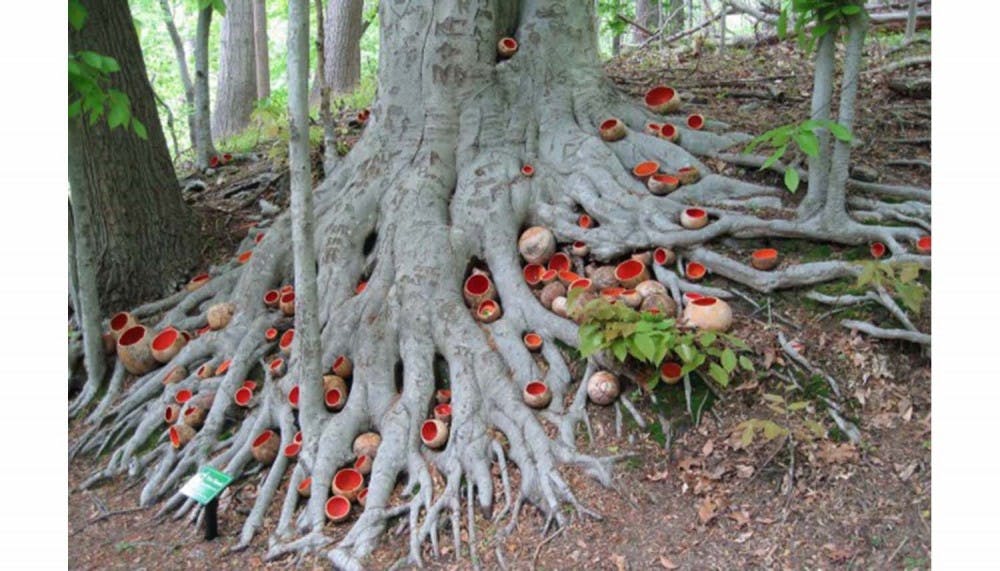The Schuylkill Center Environmental Art Program shows us that the final resting place for a piece of art doesn’t have to be in the inside of a museum. Instead, it shows us that art not only can art exist outdoors, but also that art can connect us to the environment. For those unfamiliar with what exactly “environmental art” entails, it generally takes the form of outdoor sculpture. Often it either interacts directly with, or is made from, living material, and its subject matter or focus is usually geared towards representing and facilitating discussion of environmental issues.
Anna Lehr Mueser, the manager of Communications and Digital Strategy at The Schuylkill Center's Environmental Art program explains, “Some of the art work done here is about educating about Environmental Science or Ecology, and some of them are about people thinking and feeling differently about natural things they encounter….It’s all about getting people to form meaningful connections with nature." Summing it up, Anna explains that most people think of green art as “art in the environment,” but at the Schuylkill Center, they think of it as “art with the environment.”
Just outside the neighborhood of Roxborough, The Schuylkill Center is about a 40 minute drive from campus. On a nice day, Anna recommends strolling down the Schuylkill River Path to get there. The Environmental Art Program is one of four core programs at the Schuylkill Center for Environmental Education. The other three sectors include Education, Land Stewardship/Restoration, and a Wildlife Clinic for sick and or injured animals. These distinctions are somewhat arbitrary, since each program works so closely with the others. Jenny Ryder, an Environmental Art and PR Intern, notes that the center takes a very interdisciplinary approach, and the art program especially is aimed towards both education and restoration.
Jenny notes that almost all of the art projects have an educational aspect, and more and more are starting to have a functional side as well. Some of the projects, such as Rain Yard, actually solve an environmental problem, and do so in an aesthetically pleasing way (check out some of the other projects here). Rain Yard, which Anna describes as an “indefinite” installation (meaning they’ll leave it up until there’s a reason to take it down), was designed by Stacy Levy, and speaks to the problem of rainwater distribution. Created as an intricate installation of pipes, buckets, and pumps, Rain Yard plays on the idea of constructive redirection of water. In most urban areas, rainwater usually pools in still areas or is directed towards a storm drain. Rain Yard on the other hand, redirects the water down snake–like royal blue pipes to the garden below the viewer’s feet. The result creates a soothing, supple cascade of water, and, perhaps more importantly, brings life to the plants below.

Like Rain Yard, Jenny and Anna also point to Land Lab as another example of their art having a double nature, both as something aesthetically pleasing, and as something functional. Land Lab is a residential program that artists can apply to through the Center For Emerging Visual Artists, and is geared towards creating art that also uplifts the ecosystem. On this, Anna categorizes a lot of the art as an “intervention.” Jenny responds, “Anna used the word intervention. That’s a good way of understanding Land Lab is supposed to be doing… It’s supposed to facilitate art being done on our property as a living laboratory experiment.” "WE THE WEEDS," created by Zya Levy and Kaitlin Pomerantz and pictured below, is a perfect example of the interactive nature of the Land Lab's projects.

Anna explains what she sees as an interesting shift in the environmental art world, that both Rain Yard and Land Lab are getting at. She notes, that at the Center, the art projects are constantly evolving and changing: “with time, with natural processes…you don’t know exactly what’s going to happen— how the environment around it is going to interact with it, how the ecosystem will respond. And so you adapt accordingly— you might need to update the sculpture in this way, or it might reach a point when you have to take it down.” She then goes on to explain how this way of thinking alters the creative process. Instead of creation stopping at the moment of installation, the project continues to develop as it coexists with the elements; she describes the moment of installation, “as the midpoint….The next part of the artwork is the phase in which it’s interacting over time with the ecosystem—” Jenny cuts in and adds, “—with the ecosystem including people. That’s another fun part of our art…Everyone at the Schuylkill Center is just trying to find creative and fun ways to engage people with science and ecology and the natural world… and a lot of our art projects invite the public to come and engage with them.”
Another upcoming event, Art in the Open, will be a free event open to the public starting May 24th. It will have a variety of projects across all types of media; there will be an open–air accordion performance, an interactive pine tree grove, outdoor poetry, and an indoor gallery portion. Both are excited for the event, and hope to that Penn summer students have an opportunity to check it out. Anna, an alumna from Penn, explains what she feels the Schuylkill Center and Penn have in common, “There’s a lot of interest at Penn now with engaging with the environment… and kind of the interpretive human aspects of environmental issues. The Schuylkill center generally is very connected to those conversations, but specifically the art program offers a member of the Penn community an opportunity to see some of those theoretical concepts in action.”

